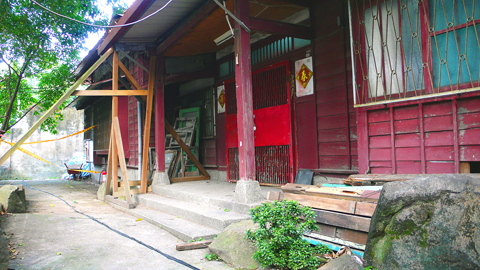The Taipei City Government yesterday started a restoration project on a group of Japanese-style houses built on Qidong Street in the 1920s in an effort to preserve the city’s largest group of such buildings.
The narrow street, located at the intersection of Zhongxiao E Road and Jinshan S Road, has a total of 10 houses built for civil servants during the Japanese colonial era. Occupying more than 6,800m², this kind of architecture has become rare even in Japan, Taipei City’s Department of Cultural Affairs said.
“The wooden structures make the preservation of historical Japanese buildings a challenge, and even in Japan, most old buildings were destroyed or dismantled to make way for urban renewal projects,” Teng Wen-tsung (鄧文宗), a division chief in the department, said during a press conference in front of the houses yesterday.

PHOTO: LIN HSIANG-MEI, TAIPEI TIMES
The area originally comprised 17 houses, but seven were torn down by Bank of Taiwan, which owned the land, in 2002.
To preserve the remaining houses, the government revised regulations in the Cultural Assets Preservation Act (文化資產保存法) and protected the houses as “temporary historical sites” before formally listing them as municipal historical sites in 2004.
Although the 10 remaining houses have been abandoned for years, the interior decorations and a total of 12 old trees are well preserved, Teng said.
The buildings show how people lived during the Japanese colonial era, Teng said.
The restoration project will cost NT$22 million (US$650,000) and will be completed next year.
Chu Chen Pao-kuei (褚陳寶貴), a local resident, said the efforts to preserve the houses were initiated by the local community. The community will cooperate with the department and the Council of Cultural Affairs to preserve the buildings, Chu said.
Lee Yong-ping (李永萍), commissioner of the department, said the restored houses would be open to the public.

ANOTHER EMERGES: The CWA yesterday said this year’s fourth storm of the typhoon season had formed in the South China Sea, but was not expected to affect Taiwan Tropical Storm Gaemi has intensified slightly as it heads toward Taiwan, where it is expected to affect the country in the coming days, the Central Weather Administration (CWA) said yesterday. As of 8am yesterday, the 120km-radius storm was 800km southeast of Oluanpi (鵝鑾鼻), Taiwan’s southernmost tip, moving at 9kph northwest, the agency said. A sea warning for Gaemi could be issued tonight at the earliest, it said, adding that the storm is projected to be closest to Taiwan on Wednesday or Thursday. Gaemi’s potential effect on Taiwan remains unclear, as that would depend on its direction, radius and intensity, forecasters said. Former Weather Forecast

As COVID-19 cases in Japan have been increasing for 10 consecutive weeks, people should get vaccinated before visiting the nation, the Centers for Disease Control (CDC) said. The centers reported 773 hospitalizations and 124 deaths related to COVID-19 in Taiwan last week. CDC Epidemic Intelligence Center Director Guo Hung-wei (郭宏偉) on Tuesday said the number of weekly COVID-19 cases reported in Japan has been increasing since mid-May and surpassed 55,000 cases from July 8 to July 14. The average number of COVID-19 patients at Japan’s healthcare facilities that week was also 1.39 times that of the week before and KP.3 is the dominant

The Chinese Communist Party’s (CCP) working group for Taiwan-related policies is likely to be upgraded to a committee-level body, a report commissioned by the Mainland Affairs Council (MAC) said. As Chinese President Xi Jinping (習近平) is increasingly likely to upgrade the CCP’s Central Leading Group for Taiwan Affairs, Taiwanese authorities should prepare by researching Xi and the CCP, the report said. At the third plenary session of the 20th Central Committee of the CCP, which ended on Thursday last week, the party set a target of 2029 for the completion of some tasks, meaning that Xi is likely preparing to

US-CHINA TRADE DISPUTE: Despite Beijing’s offer of preferential treatment, the lure of China has dimmed as Taiwanese and international investors move out Japan and the US have become the favored destinations for Taiwanese graduates as China’s attraction has waned over the years, the Ministry of Labor said. According to the ministry’s latest income and employment advisory published this month, 3,215 Taiwanese university graduates from the class of 2020 went to Japan, surpassing for the first time the 2,881 graduates who went to China. A total of 2,300 graduates from the class of 2021 went to the US, compared with the 2,262 who went to China, the document showed. The trend continued for the class of 2023, of whom 1,460 went to Japan, 1,334 went to